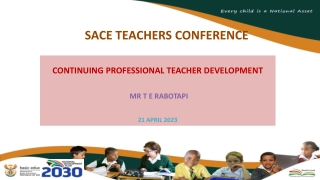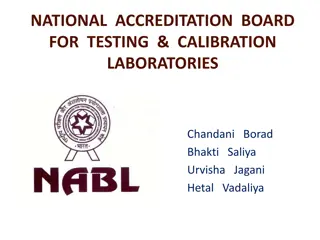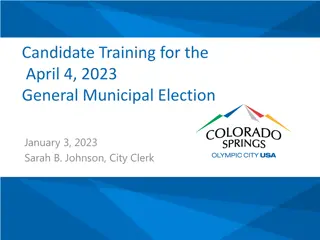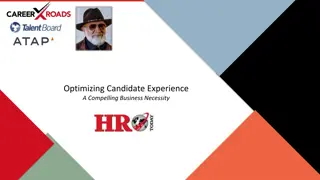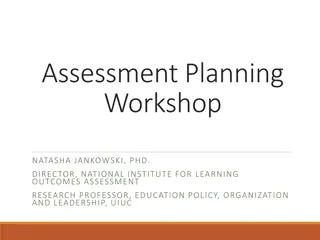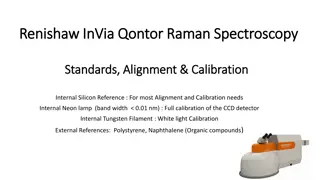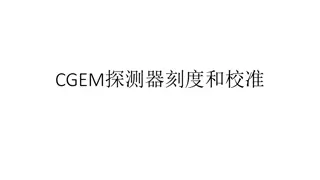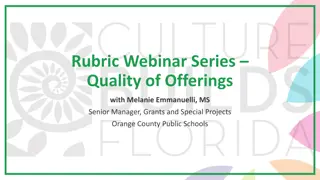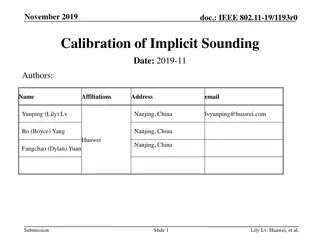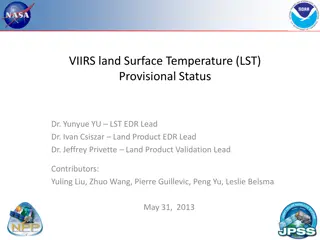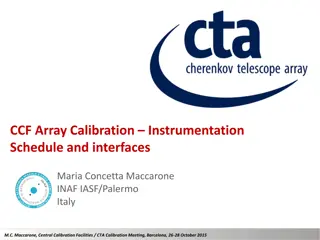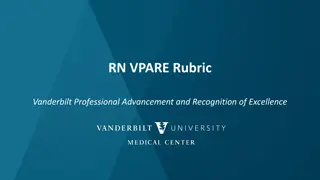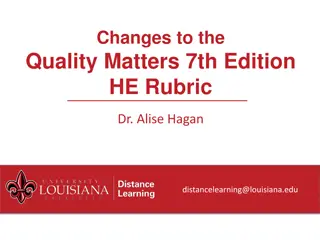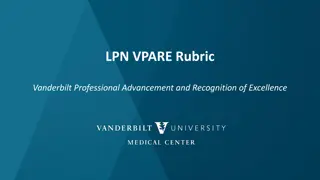MEES Teacher Candidate Assessment Rubric and Calibration Training
This training provides a comprehensive overview of the MEES teacher candidate assessment rubric and calibration techniques to ensure accurate evaluations. Participants will learn key principles, strategies, and best practices to enhance assessment practices.
Download Presentation

Please find below an Image/Link to download the presentation.
The content on the website is provided AS IS for your information and personal use only. It may not be sold, licensed, or shared on other websites without obtaining consent from the author.If you encounter any issues during the download, it is possible that the publisher has removed the file from their server.
You are allowed to download the files provided on this website for personal or commercial use, subject to the condition that they are used lawfully. All files are the property of their respective owners.
The content on the website is provided AS IS for your information and personal use only. It may not be sold, licensed, or shared on other websites without obtaining consent from the author.
E N D
Presentation Transcript
MEES Teacher Candidate Assessment Rubric and Calibration Training
Outcomes Review the MEES Teacher Candidate Assessment Rubric Review the scoring protocol Use the MEES instrument to score videos and check for inter-rater reliability Understand the value of actionable feedback as part of the evaluation process
Scoring Standards Standard 1: Content Knowledge Standard 2: Student Learning, Growth, and Development Standard 3: Curriculum Implementation Standard 4: Critical Thinking Standard 5: Positive Classroom Environment Standard 6: Effective Communication Standard 7: Student Assessment & Data Analysis Standard 8: Self-Assessment & Improvement Standard 9: Professional Collaboration
0-The teacher candidate does not possess the necessary knowledge, therefore, the standard is not evident or is incorrect in performance. 1-Emerging Candidate: The teacher candidate is able to articulate the necessary knowledge, but does not demonstrate in performance. 2-Developing Candidate: The teacher candidate is able to articulate the necessary knowledge and demonstrates in performance with some success. 3-Skilled Candidate: The teacher candidate is able to articulate the necessary knowledge and effectively demonstrates in performance. 4- Exceeding Candidate: The teacher candidate adapts and develops the lesson according to the teaching environment/ student response.
Artifacts/Evidence Some standards are not observable within a lesson Additional evidence/artifacts will be determined by the EPP
Reviewing the Rubric Cooperating Teachers, University Supervisors, and Teacher Candidates review the rubric in Breakout Rooms Within the assigned standard, identify key language that distinguishes each level of development. Generate classroom examples Discuss possible artifacts/evidence
Scoring Protocol Determining Score: For levels 0 3, a score earned on a majority of the strands will be the score assigned to that standard. For standards with an even number of strands, if the scores are split evenly between two adjacent levels, the lower score will be given. For example, if there are two descriptors that fall within a 2 and two descriptors that fall within a 3, a score of 2 will be assigned.
Example Score of 3 Majority Standard 1: Content knowledge aligned with appropriate instruction. The teacher candidate understands the central concepts, structures, and tools of inquiry of the discipline(s) and creates learning experiences that make these aspects of subject matter meaningful and engaging for students. 0-The teacher candidate does not possess the necessary knowledge, therefore, the standard is not evident or is incorrect in performance. 1-Emerging Candidate: The teacher candidate is able to articulate the necessary knowledge, but does not demonstrate in performance. 2-Developing Candidate: The teacher candidate is able to articulate the necessary knowledge and demonstrates in performance with some success. 3-Skilled Candidate: The teacher candidate is able to articulate the necessary knowledge and effectively demonstrates in performance. 4-Exceeding Candidate: The teacher candidate adapts and develops the lesson according to the teaching environment/ student response (all descriptors in the skilled candidate (3) column must be met as well as at least one descriptor below): Expected level of performance by the end of the student teaching semester. Provides no opportunity for students to process content. Demonstrates an awareness of strategies to allow students to process content. Provides students limited opportunities to process content. Provides students with multiple opportunities to process the content. Identifies low engagement and responds with strategies to increase engagement. Uses a variety of skillful questioning strategies to promote active participation and depth of student response. Shares incorrect information. Demonstrates an understanding of basic content. Conveys accurate content knowledge, relevant examples, and content-specific resources to engage students and support learning. Conveys accurate information when teaching content. Facilitates a lesson in which every student in the class appears engaged for the duration of the lesson. Provides no evidence of addressing needed vocabulary and/or terminology for student understanding of content. Plans to introduce vocabulary and terminology, but does not use strategies to enhance student engagement and responses. Introduces vocabulary and terminology necessary to understand content, but uses limited strategies to engage students Conveys vocabulary and terminology necessary to understand content and uses evidence-based instructional strategies to engage students. Promotes students authentically using vocabulary and terminology relevant to the content. Provides no evidence of planning for student engagement. Plans for student engagement but no evidence of implementation. Inconsistently engages students in the content. Consistently engages the majority of students in the content.
Example Score of 2 Split Score Standard 1: Content knowledge aligned with appropriate instruction. The teacher candidate understands the central concepts, structures, and tools of inquiry of the discipline(s) and creates learning experiences that make these aspects of subject matter meaningful and engaging for students. 0-The teacher candidate does not possess the necessary knowledge, therefore, the standard is not evident or is incorrect in performance. 1-Emerging Candidate: The teacher candidate is able to articulate the necessary knowledge, but does not demonstrate in performance. 2-Developing Candidate: The teacher candidate is able to articulate the necessary knowledge and demonstrates in performance with some success. 3-Skilled Candidate: The teacher candidate is able to articulate the necessary knowledge and effectively demonstrates in performance. 4-Exceeding Candidate: The teacher candidate adapts and develops the lesson according to the teaching environment/ student response (all descriptors in the skilled candidate (3) column must be met as well as at least one descriptor below): Expected level of performance by the end of the student teaching semester. Provides no opportunity for students to process content. Demonstrates an awareness of strategies to allow students to process content. Provides students limited opportunities to process content. Provides students with multiple opportunities to process the content. Identifies low engagement and responds with strategies to increase engagement. Uses a variety of skillful questioning strategies to promote active participation and depth of student response. Shares incorrect information. Demonstrates an understanding of basic content. Conveys accurate content knowledge, relevant examples, and content-specific resources to engage students and support learning. Conveys accurate information when teaching content. Facilitates a lesson in which every student in the class appears engaged for the duration of the lesson. Provides no evidence of addressing needed vocabulary and/or terminology for student understanding of content. Plans to introduce vocabulary and terminology, but does not use strategies to enhance student engagement and responses. Introduces vocabulary and terminology necessary to understand content, but uses limited strategies to engage students Conveys vocabulary and terminology necessary to understand content and uses evidence-based instructional strategies to engage students. Promotes students authentically using vocabulary and terminology relevant to the content. Provides no evidence of planning for student engagement. Plans for student engagement but no evidence of implementation. Inconsistently engages students in the content. Consistently engages the majority of students in the content.
Scoring Protocol Determining Score: If neither of the first two previous rules applies, the mean of all strand scores should be calculated and used as the standard score. This score should be rounded down if the mean is *.5 Teacher candidates must demonstrate all of the skilled level (3) plus at least one of the exceeding descriptors to earn a 4. If a particular strand within a standard is not observable, score the standard based on the evidence available.
Example Score of 2 Mean Score Standard 1: Content knowledge aligned with appropriate instruction. The teacher candidate understands the central concepts, structures, and tools of inquiry of the discipline(s) and creates learning experiences that make these aspects of subject matter meaningful and engaging for students. 0-The teacher candidate does not possess the necessary knowledge, therefore, the standard is not evident or is incorrect in performance. 1-Emerging Candidate: The teacher candidate is able to articulate the necessary knowledge, but does not demonstrate in performance. 2-Developing Candidate: The teacher candidate is able to articulate the necessary knowledge and demonstrates in performance with some success. 3-Skilled Candidate: The teacher candidate is able to articulate the necessary knowledge and effectively demonstrates in performance. 4-Exceeding Candidate: The teacher candidate adapts and develops the lesson according to the teaching environment/ student response (all descriptors in the skilled candidate (3) column must be met as well as at least one descriptor below): Expected level of performance by the end of the student teaching semester. Provides no opportunity for students to process content. Demonstrates an awareness of strategies to allow students to process content. Provides students limited opportunities to process content. Provides students with multiple opportunities to process the content. Identifies low engagement and responds with strategies to increase engagement. Uses a variety of skillful questioning strategies to promote active participation and depth of student response. Shares incorrect information. Demonstrates an understanding of basic content. Conveys accurate content knowledge, relevant examples, and content-specific resources to engage students and support learning. Conveys accurate information when teaching content. Facilitates a lesson in which every student in the class appears engaged for the duration of the lesson. Provides no evidence of addressing needed vocabulary and/or terminology for student understanding of content. Plans to introduce vocabulary and terminology, but does not use strategies to enhance student engagement and responses. Introduces vocabulary and terminology necessary to understand content, but uses limited strategies to engage students Conveys vocabulary and terminology necessary to understand content and uses evidence-based instructional strategies to engage students. Promotes students authentically using vocabulary and terminology relevant to the content. Provides no evidence of planning for student engagement. Plans for student engagement but no evidence of implementation. Inconsistently engages students in the content. Consistently engages the majority of students in the content.
Example Score of 4 Standard 1: Content knowledge aligned with appropriate instruction. The teacher candidate understands the central concepts, structures, and tools of inquiry of the discipline(s) and creates learning experiences that make these aspects of subject matter meaningful and engaging for students. 0-The teacher candidate does not possess the necessary knowledge, therefore, the standard is not evident or is incorrect in performance. 1-Emerging Candidate: The teacher candidate is able to articulate the necessary knowledge, but does not demonstrate in performance. 2-Developing Candidate: The teacher candidate is able to articulate the necessary knowledge and demonstrates in performance with some success. 3-Skilled Candidate: The teacher candidate is able to articulate the necessary knowledge and effectively demonstrates in performance. 4-Exceeding Candidate: The teacher candidate adapts and develops the lesson according to the teaching environment/ student response (all descriptors in the skilled candidate (3) column must be met as well as at least one descriptor below): Expected level of performance by the end of the student teaching semester. Provides no opportunity for students to process content. Demonstrates an awareness of strategies to allow students to process content. Provides students limited opportunities to process content. Provides students with multiple opportunities to process the content. Identifies low engagement and responds with strategies to increase engagement. Uses a variety of skillful questioning strategies to promote active participation and depth of student response. Shares incorrect information. Demonstrates an understanding of basic content. Conveys accurate content knowledge, relevant examples, and content-specific resources to engage students and support learning. Conveys accurate information when teaching content. Facilitates a lesson in which every student in the class appears engaged for the duration of the lesson. Provides no evidence of addressing needed vocabulary and/or terminology for student understanding of content. Plans to introduce vocabulary and terminology, but does not use strategies to enhance student engagement and responses. Introduces vocabulary and terminology necessary to understand content, but uses limited strategies to engage students Conveys vocabulary and terminology necessary to understand content and uses evidence-based instructional strategies to engage students. Promotes students authentically using vocabulary and terminology relevant to the content. Provides no evidence of planning for student engagement. Plans for student engagement but no evidence of implementation. Inconsistently engages students in the content. Consistently engages the majority of students in the content.
Calibration Every teacher candidate in the state is evaluated using the same instrument The MEES Teacher Candidate Assessment is the sole performance assessment for the state of Missouri Candidates must receive a specified score to receive teacher certification; the cut score for the 2020-2021 academic year is 42. This is the combined score of the Cooperating Teacher and University Supervisor. Accurate scoring provides Teacher Candidates with valuable feedback
Calibration Base your score on observable data only Highlight each strand within the rubric to determine the score Record specific evidence to support your score Review the language carefully and choose the score that aligns to the performance Do not include inferences about what the candidate may have done Consider what feedback might be the most impactful to improve teaching practices
Common Language Standard 1: Content knowledge aligned with appropriate instruction. The teacher candidate understands the central concepts, structures, and tools of inquiry of the discipline(s) and creates learning experiences that make these aspects of subject matter meaningful and engaging for students. 0-The teacher candidate does not possess the necessary knowledge, therefore, the standard is not evident or is incorrect in performance. 1-Emerging Candidate: The teacher candidate is able to articulate the necessary knowledge, but does not demonstrate in performance. Level 2-Developing Candidate: The teacher candidate is able to articulate the necessary knowledge and demonstrates in performance with some success. 3-Skilled Candidate: The teacher candidate is able to articulate the necessary knowledge and effectively demonstrates in performance. 4-Exceeding Candidate: The teacher candidate adapts and develops the lesson according to the teaching environment/ student response (all descriptors in the skilled candidate (3) column must be met as well as at least one descriptor below): Expected level of performance by the end of the student teaching semester. Provides no opportunity for students to process content. Demonstrates an awareness of strategies to allow students to process content. Provides students limited opportunities to process content. Provides students with multiple opportunities to process the content. Identifies low engagement and responds with strategies to increase engagement. Strand Uses a variety of skillful questioning strategies to promote active participation and depth of student response. Shares incorrect information. Demonstrates an understanding of basic content. Conveys accurate content knowledge, relevant examples, and content-specific resources to engage students and support learning. Conveys accurate information when teaching content. Facilitates a lesson in which every student in the class appears engaged for the duration of the lesson. Provides no evidence of addressing needed vocabulary and/or terminology for student understanding of content. Introduces vocabulary and terminology necessary to understand content, but uses limited strategies to engage students Descriptor Conveys vocabulary and terminology necessary to understand content and uses evidence-based instructional strategies to engage students. Plans to introduce vocabulary and terminology, but does not use strategies to enhance student engagement and responses. Promotes students authentically using vocabulary and terminology relevant to the content. Provides no evidence of planning for student engagement. Plans for student engagement but no evidence of implementation. Inconsistently engages students in the content. Consistently engages the majority of students in the content.
Practice Scoring Round 1 View the 2nd Grade Math Video Individually: Score Standards 2, 5, & 7 Record evidence for scoring CT, US, TC as a Group: Share your evidence Discuss what artifacts might be helpful to support scoring Consider the feedback you might share
Standard 2: Score of 2 Standard 2: Student Learning, Growth, and Development. The teacher candidate understands how students learn, develop, and differ in their approaches to learning. The teacher candidate provides learning opportunities that are adapted to diverse learners and support the intellectual, social, and personal development of all students. 0-The teacher candidate does not possess the necessary knowledge, therefore, the standard is not evident or is incorrect in performance. 1-Emerging Candidate: The teacher candidate is able to articulate the necessary knowledge, but does not demonstrate in performance. 2-Developing Candidate: The teacher candidate is able to articulate the necessary knowledge and demonstrates in performance with some success. 3-Skilled Candidate: The teacher candidate is able to articulate the necessary knowledge and effectively demonstrates in performance. 4-Exceeding Candidate: The teacher candidate adapts and develops the lesson according to the teaching environment/ student response (all descriptors in the skilled candidate (3) column must be met as well as at least one descriptor below): Adjusts strategies in the moment based on individual student needs. Expected level of performance by the end of the student teaching semester. Provides no evidence of differentiating content, process, product, or environment or shows no awareness of student differences. Describes strategies to differentiate and adjust instruction based on student differences. Varies activities and strategies within a lesson but does not intentionally consider individual student differences represented in the classroom. Implements lessons that intentionally vary one or more of the following in order to address student differences: content, process, product, or environment. Uses individual student data or assessments to inform the selection and modification of strategies. Provides no evidence of understanding students background knowledge and learning needs. Demonstrates understanding that some students may require differentiation based on cognitive, social, emotional, and physical needs. Applies knowledge of individual students needs and interests by selecting a variety of evidence- based strategies, including any necessary accommodations or modifications. Uses evidence-based strategies for differentiation, though choices in strategies are not matched to some students needs and interests. Goes beyond food, holidays, and customs to acknowledge and explore deeper cultural expectations (sociolinguistics) and communication strategies (pragmatics) in classroom instruction and interactions. Provides no evidence of understanding students languag es, family, culture, and community needs. Demonstrates understanding of students languages, family, culture, and community in planning. Integrates understanding of students languages, family, culture, and community when selecting, creating, and facilitating learning opportunities. Affirms students languages, family, culture, and community during learning opportunities.
Evidence to Support Score Varies number bond by modeling with students and using the Smartboard, graphic organizer, and counters Repetition of vocabulary Small group work need additional evidence of rationale of grouping Demonstrates understanding of students languages
Standard 5: Score of 3 Standard 5: Positive Classroom Environment. The teacher candidate uses an understanding of individual/group motivation and behavior to create a learning environment that encourages active engagement in learning, positive social interaction, and self-motivation. 0-The teacher candidate does not possess the necessary knowledge, therefore, the standard is not evident or is incorrect in performance. 1-Emerging Candidate: The teacher candidate is able to articulate the necessary knowledge, but does not demonstrate in performance. 2-Developing Candidate: The teacher candidate is able to articulate the necessary knowledge and demonstrates in performance with some success. 3-Skilled Candidate: The teacher candidate is able to articulate the necessary knowledge and effectively demonstrates in performance. 4-Exceeding Candidate: The teacher candidate adapts and develops the lesson according to the teaching environment/ student response (all descriptors in the skilled candidate (3) column must be met as well as at least one descriptor below): Expected level of performance by the end of the student teaching semester. Provides no evidence of classroom expectations that would contribute to a safe learning environment. Plans to communicate expectations to maintain a safe learning environment. Communicates expectations to students in advance, though may not consistently maintain these expectations throughout the lesson. Implements developmentally appropriate expectations to maintain a respectful and safe learning environment. Involves all students in creating a safe learning environment that respects differences and individual preferences. Seeks feedback from students on his or her teaching, strategies, classroom, etc. Facilitates an environment that supports student self-monitoring to maximize instructional time and student learning. Displays a lack of awareness of how to build appropriate relationships with students. Describes strategies for building appropriate relationships with students. Fosters positive social interactions in the classroom. Maintains positivity in formal and informal interactions, which encourages students to actively engage in learning. Effectively uses varied management or organizational strategies to motivate students and minimize interference with classroom instruction. Provides no evidence of strategies for monitoring student behavior and addressing disruptions. Explains strategies for monitoring student behavior and minimizing disruptions. Responds appropriately to classroom disruptions. Proactively uses varied classroom management strategies to minimize disruptions to the learning environment.
Evidence to Support Score Safe and respectful learning environment Positivity maintained verbal & physical encouragement, i.e. high fives Most students worked independently without prompting Proactive steps to minimize disruption removed cups/counters as needed
Standard 7: Score of 2 Standard 7: Student Assessment and Data Analysis. The teacher candidate understands and uses formative and summative assessment strategies to assess the learner s progress and uses both classroom and standardized assessment data to plan ongoing instruction. 0-The teacher candidate does not possess the necessary knowledge, therefore, the standard is not evident or is incorrect in performance. 1-Emerging Candidate: The teacher candidate is able to articulate the necessary knowledge, but does not demonstrate in performance. 2-Developing Candidate: The teacher candidate is able to articulate the necessary knowledge and demonstrates in performance with some success. 3-Skilled Candidate: The teacher candidate is able to articulate the necessary knowledge and effectively demonstrates in performance. 4-Exceeding Candidate: The teacher candidate adapts and develops the lesson according to the teaching environment/ student response (all descriptors in the skilled candidate (3) column must be met as well as at least one descriptor below): Expected level of performance by the end of the student teaching semester. Provides no evidence of data from assessments to monitor the progress of students. Articulates the importance of collecting assessment data. Uses formative and summative assessment data to monitor the progress of the class as a whole. Analyzes trend data to respond instructionally, resulting in a positive impact on student learning. Uses formative and summative assessment data to effectively monitor the progress of individual students and the class as a whole. Uses multiple assessments to accurately monitor, analyze, and triangulate the progress of each student and the class as a whole. Provides no awareness that formative assessments are needed to guide future instruction. Articulates the need to use formative assessment strategies to gather data on student understanding to guide future instruction. Uses some formative assessment strategies to partially gather data on student understanding and sporadically implements adjustments to plan future instruction. Uses formative assessment strategies to effectively gather data about student understanding and uses it to plan future instruction. Supports students in creating and articulating progress toward goals. Uses formative assessment strategies to adjust mid-lesson instruction. Provides no evidence of an understanding of maintaining student assessment records. Articulates a process for maintaining student assessment records. Confidentially maintains student assessment records, though processes are inconsistent. Maintains student assessment records consistently and confidentially. Not Scored
Evidence to Support Score Monitors student understanding during whole group time Monitors individual understanding during small group each student completes one independently Verbal and written opportunities for assessment Unclear how data may be used to group students
Overall Feedback & Guiding Questions What expectations were put in place to support successful independent work? How might you support students to find multiple ways to make a number? What strategies could be incorporated to encourage students to self-monitor and check their own work? What questions might be asked to the student who had 7 counters instead of 6?
Practice Scoring Round 2 View the Elementary 4th Grade Social Studies Video Individually: Score Standards 4, 5, & 6 Record evidence for scoring CT, US, TC as a Group: Share your evidence Discuss what artifacts might be helpful to support scoring Consider the feedback you might share
Standard 4: Score of 0 Standard 4: Critical Thinking. The teacher candidate uses a variety of instructional strategies and resources to encourage students critical thinking, problem solving, and performance skills. 0-The teacher candidate does not possess the necessary knowledge, therefore, the standard is not evident or is incorrect in performance. 1-Emerging Candidate: The teacher candidate is able to articulate the necessary knowledge, but does not demonstrate in performance. 2-Developing Candidate: The teacher candidate is able to articulate the necessary knowledge and demonstrates in performance with some success. 3-Skilled Candidate: The teacher candidate is able to articulate the necessary knowledge and effectively demonstrates in performance. 4-Exceeding Candidate: The teacher candidate adapts and develops the lesson according to the teaching environment/ student response (all descriptors in the skilled candidate (3) column must be met as well as at least one descriptor below): Expected level of performance by the end of the student teaching semester. Demonstrates no awareness of the importance of students sharing ideas and generating possible solutions. Provides no evidence of knowledge of importance of student analysis and discussion of problems and possible solutions. Plans strategies to facilitate opportunities for students to share ideas and generate possible solutions. Uses strategies for some students to share ideas and generate possible solutions. Implements strategies in which most students convey their ideas or solutions through product or process. Facilitates student-centered lessons in which students discover for themselves the desired knowledge or skills, rather than relying on teacher-provided information. Plans strategies for analyzing and discussing problems and possible solutions. Creates opportunities for some students to analyze and discuss problems and possible solutions. Facilitates opportunities in which most students analyze and discuss problems and possible solutions. Provides opportunities for students to demonstrate creativity, engage in creative problem-solving, and develop curiosity through hands-on experiences. Allows students to express their thoughts, feelings, insights, opinions, and attitudes (not just knowledge) through a variety of media. Provides no evidence of using questions that promote critical thinking. Plans to use questions that promote critical thinking. Uses questioning techniques that promote students critical thinking. Uses questioning techniques that result in most students providing answers reflecting critical thinking. Consistently uses evidence-based strategies to promote higher order thinking. Provides no evidence of higher order thinking. Plans for higher order thinking. Uses strategies to incorporate higher order thinking. Provides opportunities for student thinking to delve into real-world topics, which address differing
Evidence to Support Score Students not allowed time to process and make meaning Lost opportunity to ask questions to promote dialogue and critical thinking No evidence of understanding the importance of problem solving and creativity
Standard 5: Score of 1 Standard 5: Positive Classroom Environment. The teacher candidate uses an understanding of individual/group motivation and behavior to create a learning environment that encourages active engagement in learning, positive social interaction, and self-motivation. 0-The teacher candidate does not possess the necessary knowledge, therefore, the standard is not evident or is incorrect in performance. 1-Emerging Candidate: The teacher candidate is able to articulate the necessary knowledge, but does not demonstrate in performance. 2-Developing Candidate: The teacher candidate is able to articulate the necessary knowledge and demonstrates in performance with some success. 3-Skilled Candidate: The teacher candidate is able to articulate the necessary knowledge and effectively demonstrates in performance. 4-Exceeding Candidate: The teacher candidate adapts and develops the lesson according to the teaching environment/ student response (all descriptors in the skilled candidate (3) column must be met as well as at least one descriptor below): Expected level of performance by the end of the student teaching semester. Provides no evidence of classroom expectations that would contribute to a safe learning environment. Plans to communicate expectations to maintain a safe learning environment. Communicates expectations to students in advance, though may not consistently maintain these expectations throughout the lesson. Implements developmentally appropriate expectations to maintain a respectful and safe learning environment. Involves all students in creating a safe learning environment that respects differences and individual preferences. Seeks feedback from students on his or her teaching, strategies, classroom, etc. Facilitates an environment that supports student self-monitoring to maximize instructional time and student learning. Displays a lack of awareness of how to build appropriate relationships with students. Describes strategies for building appropriate relationships with students. Fosters positive social interactions in the classroom. Maintains positivity in formal and informal interactions, which encourages students to actively engage in learning. Effectively uses varied management or organizational strategies to motivate students and minimize interference with classroom instruction. Provides no evidence of strategies for monitoring student behavior and addressing disruptions. Explains strategies for monitoring student behavior and minimizing disruptions. Responds appropriately to classroom disruptions. Proactively uses varied classroom management strategies to minimize disruptions to the learning environment.
Evidence to Support Score Expectations were stated, but unclearly and sometimes after students started the activity Most responses were reactive Corrections were negative in tone and did not promote positive relationships
Standard 6: Score of 1 Standard 6: Effective Communication. The teacher candidate models effective verbal, nonverbal, and media communication techniques with students, colleagues and families to foster active inquiry, collaboration, and supportive interaction in the classroom. 0-The teacher candidate does not possess the necessary knowledge, therefore, the standard is not evident or is incorrect in performance. demonstrate in performance. performance with some success. 1-Emerging Candidate: The teacher candidate is able to articulate the necessary knowledge, but does not 2-Developing Candidate: The teacher candidate is able to articulate the necessary knowledge and demonstrates in 3-Skilled Candidate: The teacher candidate is able to articulate the necessary knowledge and effectively demonstrates in performance. 4-Exceeding Candidate: The teacher candidate adapts and develops the lesson according to the teaching environment/ student response (all descriptors in the skilled candidate (3) column must be met as well as at least one descriptor below): Adjusts communication and interactions to support individual student understanding. Encourages students to develop effective speech qualities including volume, tone, and inflection or other effective communication techniques Expected level of performance by the end of the student teaching semester. Provides no evidence of instructions in lesson plan. Plans to provide instructions. Conveys instructions to students through verbal OR non-verbal cues. Conveys clear instructions through verbal AND non-verbal cues or other communication strategies; follows up with students not understanding instructions. Provides no evidence of understanding the need to articulate expectations for student communication and interaction. Plans to articulate expectations for respectful student communication and interaction. Articulates vague expectations to students about respectful communication and interaction. Articulates or models expectations for student communication and interaction with respect for diverse backgrounds or differing opinions. Uses volume, tone, inflection, or sight lines that negatively impact lesson delivery. Displays self-awareness of the impact of volume, tone, inflection, or sight lines on lesson delivery. Uses volume, tone, inflection, or sight lines that periodically impact lesson delivery. Ensures volume, tone, inflection, and sight lines positively impact lesson delivery that is sensitive to the diverse needs of students, using resources as necessary. Consistently uses and fosters correct, effective verbal and nonverbal communication, including strategies to communicate with students whose first language is not Standard English or whose disability requires specific forms of communication. Consistently includes distracting communication errors that interfere with meaning. Models proper spelling and grammar consistently in written and verbal communication. Includes communication errors that interfere with meaning. Uses communication that includes errors that do not interfere with meaning. Intentionally integrates and responds to culturally and linguistically appropriate communication, resources, or examples based on audience and context. Plans for culturally and linguistically appropriate communication, resources, or examples. Provides no evidence of culturally and linguistically appropriate communication, resources, or examples. Uses culturally and linguistically appropriate communication,
Evidence to Support Score Instructions are vague and do not provide guidance for student interaction Negative voice and tone distract from lesson delivery Monotone communication method takes away from lesson impact Lesson is scripted lost opportunity to express empathy of cultural example
Overall Feedback & Guiding Questions What strategies might be used to enhance communication in addition to verbal directions? The tone throughout the lesson was negative. How might you monitor this in future lessons? How might you incorporate more cultural sensitivity into the delivery of this lesson?
Practice Scoring Round 3 View the ELA/SS Middle School Video Individually: Score Standards 2, 4, & 6 Record evidence for scoring CT, US, TC as a Group: Share your evidence Discuss what artifacts might be helpful to support scoring Consider the feedback you might share
Standard 2: Score of 3 Standard 2: Student Learning, Growth, and Development. The teacher candidate understands how students learn, develop, and differ in their approaches to learning. The teacher candidate provides learning opportunities that are adapted to diverse learners and support the intellectual, social, and personal development of all students. 0-The teacher candidate does not possess the necessary knowledge, therefore, the standard is not evident or is incorrect in performance. 1-Emerging Candidate: The teacher candidate is able to articulate the necessary knowledge, but does not demonstrate in performance. 2-Developing Candidate: The teacher candidate is able to articulate the necessary knowledge and demonstrates in performance with some success. 3-Skilled Candidate: The teacher candidate is able to articulate the necessary knowledge and effectively demonstrates in performance. 4-Exceeding Candidate: The teacher candidate adapts and develops the lesson according to the teaching environment/ student response (all descriptors in the skilled candidate (3) column must be met as well as at least one descriptor below): Adjusts strategies in the moment based on individual student needs. Expected level of performance by the end of the student teaching semester. Provides no evidence of differentiating content, process, product, or environment or shows no awareness of student differences. Describes strategies to differentiate and adjust instruction based on student differences. Varies activities and strategies within a lesson but does not intentionally consider individual student differences represented in the classroom. Implements lessons that intentionally vary one or more of the following in order to address student differences: content, process, product, or environment. Uses individual student data or assessments to inform the selection and modification of strategies. Provides no evidence of understanding students background knowledge and learning needs. Demonstrates understanding that some students may require differentiation based on cognitive, social, emotional, and physical needs. Applies knowledge of individual students needs and interests by selecting a variety of evidence- based strategies, including any necessary accommodations or modifications. Uses evidence-based strategies for differentiation, though choices in strategies are not matched to some students needs and interests. Goes beyond food, holidays, and customs to acknowledge and explore deeper cultural expectations (sociolinguistics) and communication strategies (pragmatics) in classroom instruction and interactions. Provides no evidence of understanding students languag es, family, culture, and community needs. Demonstrates understanding of students languages, family, culture, and community in planning. Integrates understanding of students languages, family, culture, and community when selecting, creating, and facilitating learning opportunities. Affirms students languages, family, culture, and community during learning opportunities.
Evidence to Support Score Applies knowledge of individual student needs by checking in with students and supporting their understanding Lesson content is varied and integrates ELA & SS Choice of topic for video clip and article reflected an issue relevant to students family and cultural backgrounds.
Standard 4: Score of 3 Standard 4: Critical Thinking. The teacher candidate uses a variety of instructional strategies and resources to encourage students critical thinking, problem solving, and performance skills. 0-The teacher candidate does not possess the necessary knowledge, therefore, the standard is not evident or is incorrect in performance. 1-Emerging Candidate: The teacher candidate is able to articulate the necessary knowledge, but does not demonstrate in performance. 2-Developing Candidate: The teacher candidate is able to articulate the necessary knowledge and demonstrates in performance with some success. 3-Skilled Candidate: The teacher candidate is able to articulate the necessary knowledge and effectively demonstrates in performance. 4-Exceeding Candidate: The teacher candidate adapts and develops the lesson according to the teaching environment/ student response (all descriptors in the skilled candidate (3) column must be met as well as at least one descriptor below): Expected level of performance by the end of the student teaching semester. Demonstrates no awareness of the importance of students sharing ideas and generating possible solutions. Provides no evidence of knowledge of importance of student analysis and discussion of problems and possible solutions. Plans strategies to facilitate opportunities for students to share ideas and generate possible solutions. Uses strategies for some students to share ideas and generate possible solutions. Implements strategies in which most students convey their ideas or solutions through product or process. Facilitates student-centered lessons in which students discover for themselves the desired knowledge or skills, rather than relying on teacher-provided information. Plans strategies for analyzing and discussing problems and possible solutions. Creates opportunities for some students to analyze and discuss problems and possible solutions. Facilitates opportunities in which most students analyze and discuss problems and possible solutions. Provides opportunities for students to demonstrate creativity, engage in creative problem-solving, and develop curiosity through hands-on experiences. Allows students to express their thoughts, feelings, insights, opinions, and attitudes (not just knowledge) through a variety of media. Provides no evidence of using questions that promote critical thinking. Plans to use questions that promote critical thinking. Uses questioning techniques that promote students critical thinking. Uses questioning techniques that result in most students providing answers reflecting critical thinking. Consistently uses evidence-based strategies to promote higher order thinking. Provides no evidence of higher order thinking. Plans for higher order thinking. Uses strategies to incorporate higher order thinking. Provides opportunities for student thinking to delve into real-world topics, which address differing
Evidence to Support Score Provides opportunities for students to demonstrate creativity, engage in problem- solving, and develop curiosity through hands-on experiences. Allows students to respectfully justify their own opinion and solution to a problem. Students use higher order thinking skills to identify theme. Questioning strategies are used. At times the teacher seems to give students the answer before they can find itthemselves.
Standard 6: Score of 4 Standard 6: Effective Communication. The teacher candidate models effective verbal, nonverbal, and media communication techniques with students, colleagues and families to foster active inquiry, collaboration, and supportive interaction in the classroom. 0-The teacher candidate does not possess the necessary knowledge, therefore, the standard is not evident or is incorrect in performance. demonstrate in performance. performance with some success. 1-Emerging Candidate: The teacher candidate is able to articulate the necessary knowledge, but does not 2-Developing Candidate: The teacher candidate is able to articulate the necessary knowledge and demonstrates in 3-Skilled Candidate: The teacher candidate is able to articulate the necessary knowledge and effectively demonstrates in performance. 4-Exceeding Candidate: The teacher candidate adapts and develops the lesson according to the teaching environment/ student response (all descriptors in the skilled candidate (3) column must be met as well as at least one descriptor below): Adjusts communication and interactions to support individual student understanding. Encourages students to develop effective speech qualities including volume, tone, and inflection or other effective communication techniques Expected level of performance by the end of the student teaching semester. Provides no evidence of instructions in lesson plan. Plans to provide instructions. Conveys instructions to students through verbal OR non-verbal cues. Conveys clear instructions through verbal AND non-verbal cues or other communication strategies; follows up with students not understanding instructions. Provides no evidence of understanding the need to articulate expectations for student communication and interaction. Plans to articulate expectations for respectful student communication and interaction. Articulates vague expectations to students about respectful communication and interaction. Articulates or models expectations for student communication and interaction with respect for diverse backgrounds or differing opinions. Uses volume, tone, inflection, or sight lines that negatively impact lesson delivery. Displays self-awareness of the impact of volume, tone, inflection, or sight lines on lesson delivery. Uses volume, tone, inflection, or sight lines that periodically impact lesson delivery. Ensures volume, tone, inflection, and sight lines positively impact lesson delivery that is sensitive to the diverse needs of students, using resources as necessary. Consistently uses and fosters correct, effective verbal and nonverbal communication, including strategies to communicate with students whose first language is not Standard English or whose disability requires specific forms of communication. Consistently includes distracting communication errors that interfere with meaning. Models proper spelling and grammar consistently in written and verbal communication. Includes communication errors that interfere with meaning. Uses communication that includes errors that do not interfere with meaning. Intentionally integrates and responds to culturally and linguistically appropriate communication, resources, or examples based on audience and context. Plans for culturally and linguistically appropriate communication, resources, or examples. Provides no evidence of culturally and linguistically appropriate communication, resources, or examples. Uses culturally and linguistically appropriate communication,
Evidence to Support Score Provides verbal and nonverbal cues to give directions Models expectations for student communication by addressing active listening and having students rehearse before sharing ; encourages students to develop effective speech qualities Volume and tone conveyed enthusiasm but also conveyed a level of comfort and understanding. Incorporates culturally appropriate resources and examples
Overall Feedback & Guiding Questions How did you assess student understanding as you were checking in on groups? What modifications or accommodations were addressed? How might you shift your questioning techniques and/or wait time to increase critical thinking? What issues could arise when discussing a culturally sensitive topic? What future lessons will build on students strengthening their own communication skills?
Practice Scoring Round 4 View the High School Chemistry Video Individually: Score Standards 1, 4, & 7 Record evidence for scoring CT, US, TC as a Group: Share your evidence Discuss what artifacts might be helpful to support scoring Consider the feedback you might share
Standard 1: Score of 2 Standard 1: Content knowledge aligned with appropriate instruction. The teacher candidate understands the central concepts, structures, and tools of inquiry of the discipline(s) and creates learning experiences that make these aspects of subject matter meaningful and engaging for students. 0-The teacher candidate does not possess the necessary knowledge, therefore, the standard is not evident or is incorrect in performance. 1-Emerging Candidate: The teacher candidate is able to articulate the necessary knowledge, but does not demonstrate in performance. 2-Developing Candidate: The teacher candidate is able to articulate the necessary knowledge and demonstrates in performance with some success. 3-Skilled Candidate: The teacher candidate is able to articulate the necessary knowledge and effectively demonstrates in performance. 4-Exceeding Candidate: The teacher candidate adapts and develops the lesson according to the teaching environment/ student response (all descriptors in the skilled candidate (3) column must be met as well as at least one descriptor below): Expected level of performance by the end of the student teaching semester. Provides no opportunity for students to process content. Demonstrates an awareness of strategies to allow students to process content. Provides students limited opportunities to process content. Provides students with multiple opportunities to process the content. Identifies low engagement and responds with strategies to increase engagement. Uses a variety of skillful questioning strategies to promote active participation and depth of student response. Shares incorrect information. Demonstrates an understanding of basic content. Conveys accurate content knowledge, relevant examples, and content-specific resources to engage students and support learning. Conveys accurate information when teaching content. Facilitates a lesson in which every student in the class appears engaged for the duration of the lesson. Provides no evidence of addressing needed vocabulary and/or terminology for student understanding of content. Plans to introduce vocabulary and terminology, but does not use strategies to enhance student engagement and responses. Introduces vocabulary and terminology necessary to understand content, but uses limited strategies to engage students Conveys vocabulary and terminology necessary to understand content and uses evidence-based instructional strategies to engage students. Promotes students authentically using vocabulary and terminology relevant to the content. Provides no evidence of planning for student engagement. Plans for student engagement but no evidence of implementation. Inconsistently engages students in the content. Consistently engages the majority of students in the content.
Evidence to Support Score The lecture format provided students with limited opportunities to process content. Students are inconsistently engaged in the content with a limited number of student responses. The teacher does not demonstrate a depth of knowledge about the content or explain it in student friendly language. Vocabulary is not introduced with purpose or intentionality.
Standard 4: Score of 1 Standard 4: Critical Thinking. The teacher candidate uses a variety of instructional strategies and resources to encourage students critical thinking, problem solving, and performance skills. 0-The teacher candidate does not possess the necessary knowledge, therefore, the standard is not evident or is incorrect in performance. 1-Emerging Candidate: The teacher candidate is able to articulate the necessary knowledge, but does not demonstrate in performance. 2-Developing Candidate: The teacher candidate is able to articulate the necessary knowledge and demonstrates in performance with some success. 3-Skilled Candidate: The teacher candidate is able to articulate the necessary knowledge and effectively demonstrates in performance. 4-Exceeding Candidate: The teacher candidate adapts and develops the lesson according to the teaching environment/ student response (all descriptors in the skilled candidate (3) column must be met as well as at least one descriptor below): Expected level of performance by the end of the student teaching semester. Demonstrates no awareness of the importance of students sharing ideas and generating possible solutions. Provides no evidence of knowledge of importance of student analysis and discussion of problems and possible solutions. Plans strategies to facilitate opportunities for students to share ideas and generate possible solutions. Uses strategies for some students to share ideas and generate possible solutions. Implements strategies in which most students convey their ideas or solutions through product or process. Facilitates student-centered lessons in which students discover for themselves the desired knowledge or skills, rather than relying on teacher-provided information. Plans strategies for analyzing and discussing problems and possible solutions. Creates opportunities for some students to analyze and discuss problems and possible solutions. Facilitates opportunities in which most students analyze and discuss problems and possible solutions. Provides opportunities for students to demonstrate creativity, engage in creative problem-solving, and develop curiosity through hands-on experiences. Allows students to express their thoughts, feelings, insights, opinions, and attitudes (not just knowledge) through a variety of media. Provides no evidence of using questions that promote critical thinking. Plans to use questions that promote critical thinking. Uses questioning techniques that promote students critical thinking. Uses questioning techniques that result in most students providing answers reflecting critical thinking. Consistently uses evidence-based strategies to promote higher order thinking. Provides no evidence of higher order thinking. Plans for higher order thinking. Uses strategies to incorporate higher order thinking. Provides opportunities for student thinking to delve into real-world topics, which address differing
Evidence to Support Score Some students have the opportunity to share ideas, but a limited number of students are called on. Students do not engage in discussion with one another in order to analyze problems and consider solutions. Some questioning techniques are used to allow a few students to engage in a level of critical thinking, however, most questions asked do not promote higher order thinking.
Standard 7: Score of 0 Standard 7: Student Assessment and Data Analysis. The teacher candidate understands and uses formative and summative assessment strategies to assess the learner s progress and uses both classroom and standardized assessment data to plan ongoing instruction. 0-The teacher candidate does not possess the necessary knowledge, therefore, the standard is not evident or is incorrect in performance. 1-Emerging Candidate: The teacher candidate is able to articulate the necessary knowledge, but does not demonstrate in performance. 2-Developing Candidate: The teacher candidate is able to articulate the necessary knowledge and demonstrates in performance with some success. 3-Skilled Candidate: The teacher candidate is able to articulate the necessary knowledge and effectively demonstrates in performance. 4-Exceeding Candidate: The teacher candidate adapts and develops the lesson according to the teaching environment/ student response (all descriptors in the skilled candidate (3) column must be met as well as at least one descriptor below): Expected level of performance by the end of the student teaching semester. Provides no evidence of data from assessments to monitor the progress of students. Articulates the importance of collecting assessment data. Uses formative and summative assessment data to monitor the progress of the class as a whole. Analyzes trend data to respond instructionally, resulting in a positive impact on student learning. Uses formative and summative assessment data to effectively monitor the progress of individual students and the class as a whole. Uses multiple assessments to accurately monitor, analyze, and triangulate the progress of each student and the class as a whole. Provides no awareness that formative assessments are needed to guide future instruction. Articulates the need to use formative assessment strategies to gather data on student understanding to guide future instruction. Uses some formative assessment strategies to partially gather data on student understanding and sporadically implements adjustments to plan future instruction. Uses formative assessment strategies to effectively gather data about student understanding and uses it to plan future instruction. Supports students in creating and articulating progress toward goals. Uses formative assessment strategies to adjust mid-lesson instruction. Provides no evidence of an understanding of maintaining student assessment records. Articulates a process for maintaining student assessment records. Confidentially maintains student assessment records, though processes are inconsistent. Maintains student assessment records consistently and confidentially.
Evidence to Support Score Questioning of only a few students does not provide formative assessment data on the class as a whole. Previous experiments and assignments are referenced, but there is no evidence this impacts instruction. There is no evidence that data is collected on individual student understanding or recorded for future reference.
Overall Feedback & Guiding Questions What strategies might be used to increase the engagement of all students? What impact might preplanning of questions have on students opportunity to think critically? In addition to questioning, what other formative assessment strategies could be used to gauge student understanding? How do you know which students might need additional modeling or support?


